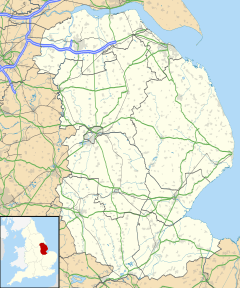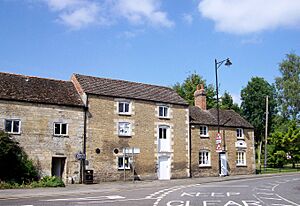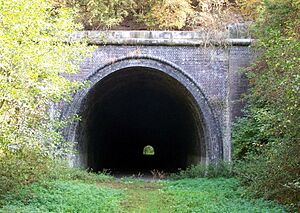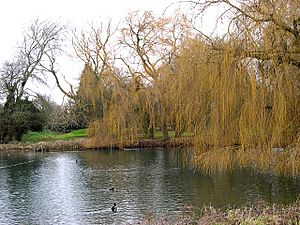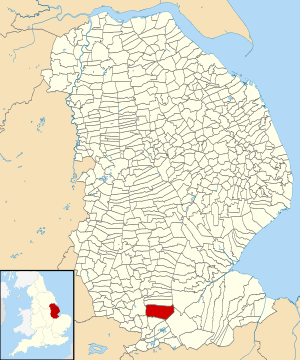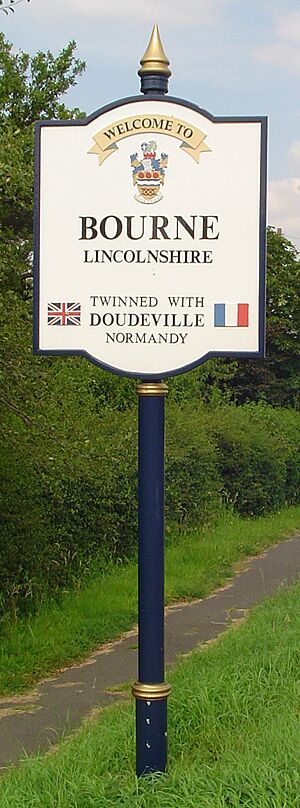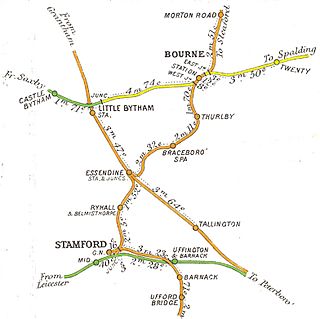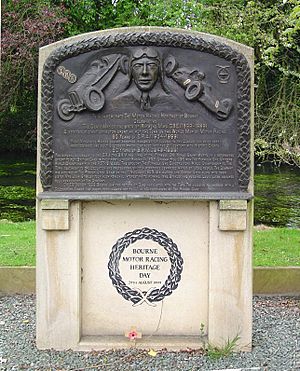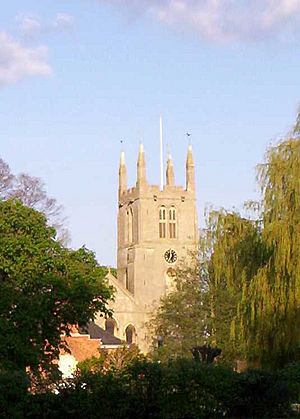Bourne, Lincolnshire facts for kids
Quick facts for kids Bourne |
|
|---|---|
| Town and civil parish | |
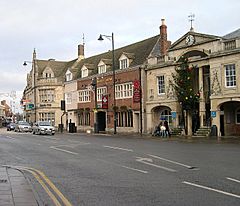 Bourne town centre |
|
| Population | 17,981 (2021 Census) |
| OS grid reference | TF094202 |
| • London | 90 mi (140 km) S |
| Civil parish |
|
| District |
|
| Shire county | |
| Region | |
| Country | England |
| Sovereign state | United Kingdom |
| Post town | BOURNE |
| Postcode district | PE10 |
| Dialling code | 01778 |
| Police | Lincolnshire |
| Fire | Lincolnshire |
| Ambulance | East Midlands |
| EU Parliament | East Midlands |
| UK Parliament |
|
Bourne is a busy market town and civil parish in Lincolnshire, England. It is located on the eastern slopes of the Kesteven Uplands and the western edge of the Fens. Bourne is about 11 miles (18 km) north-east of Stamford and 17 miles (27 km) north of Peterborough. In 2021, about 17,981 people lived here.
Contents
History of Bourne
The ancient Bourne Woods are still here today, though they are much smaller than they used to be. These woods were once part of the large Forest of Kesteven. Now, the Forestry Commission looks after them.
The name Brunna, meaning "stream", was first written down in a document from 960. Later, in the Domesday Book of 1086, the town was called Brune.
Bourne Abbey and Castle
Bourne Abbey was founded in 1138. It used to own and look after land in Bourne and nearby areas. The abbey was first set up by the Arrouaisian order, but later became known as an Augustinian abbey. A very important Middle English book called the Ormulum was probably written here around 1175.
Bourne Castle was built on land that is now the Wellhead Gardens in South Street.
Victorian Era and Railways
Bourne became a very important railway hub during the Victorian era. This meant many new businesses came to town. Many buildings in the old town centre were rebuilt or updated. Better transport also helped a bottled-water industry grow. It also made it easier to bring coal to the town's gas works.
The local council, Bourne Urban District Council, helped the town grow. They took over the gas works and watercress farms when they had money problems. Many good quality council houses were built in the early 1900s.
World War II Impact
Bourne sent many people to both world wars. However, the town itself was not heavily damaged. In May 1941, a German bomber plane was shot down. It crashed into the Butcher's Arms pub in Eastgate. The pub owner, his wife, eight soldiers, and the bomber crew all died.
About the Town
Bourne is built around natural springs, which is how it got its name. "Bourne" comes from an old Anglo-Saxon word meaning "water" or "stream". The town is on an old Roman road called King Street. It is also where two main roads, the A15 and the A151, meet.
The civil parish of Bourne includes the main town and smaller areas called hamlets. These are Cawthorpe, Dyke, and Twenty. Austerby used to be a separate village, but now it is part of Bourne.
The main church in Bourne is the Abbey Church of St Peter and St Paul. Other churches in town include Methodist, Baptist, United Reformed, and Roman Catholic churches.
In the 1800s, Bourne became wealthy from the corn trade. This happened after new machines helped drain the fens (wetlands). The Corn Exchange building, where corn was traded, was built in 1870.
How Bourne is Governed
Bourne has different levels of local government.
Lincolnshire County Council
Bourne is divided into two areas for the county council:
- Bourne North and Morton
- Bourne South and Thurlby
South Kesteven District Council
Bourne has three areas for the District Council. Two areas have two councillors, and the new area, Austerby, has three councillors.
- Bourne East
- Bourne West
- Bourne Austerby
Bourne Town Council
The Bourne Town Council has two areas, which are the same as the District Council areas. Bourne East elects seven councillors, and Bourne West elects eight.
From 1899 to 1974, Bourne had its own urban district council. When local government changed in 1974, this council became a "town council". This allowed them to keep their "town" name and their mayor.
Town Twinning
Since 1989, Bourne has been twinned with Doudeville in France. This means the two towns have a special friendship and often visit each other.
Drainage Systems
Some parts of Bourne are drained by special boards called Internal Drainage Boards. These boards help manage water levels and prevent flooding. Many houses in Bourne pay extra fees for these drainage services.
Education in Bourne
Bourne has several schools for different age groups:
- Bourne Abbey Church of England Academy (primary school)
- Bourne Grammar School (secondary school with a sixth form)
- Bourne Academy (secondary school with a sixth form)
- Bourne Westfield Primary Academy (primary school)
- Willoughby School (for students with special educational needs)
- Bourne Elsea Park Primary Academy (primary school)
Getting Around and Media
Roads
Bourne Market Place is where the A15 road and the B1193 meet.
Buses
There is a bus station at the top of North Street. Local bus services, run by Delaine Buses, offer frequent trips to Peterborough. There is also a daily long-distance coach that goes between Grimsby and London Victoria, stopping at Bourne.
Railways
Bourne used to have a railway station. It was connected to lines that went to Essendine and Sleaford. It was also part of the Midland and Great Northern Joint Railway, which linked the Midlands to East Anglia. However, all regular passenger train services stopped by early 1959.
Waterways
In Roman times, the Bourne-Morton Canal connected the town to the sea.
Until the mid-1800s, the Bourne Eau (a local waterway) could carry boats for trade from the Wash coast and Spalding. This changed in 1860 when a sluice (a gate to control water flow) was built, making it impossible for boats to pass.
Media
Local news and TV shows for Bourne come from BBC Yorkshire and Lincolnshire and ITV Yorkshire. You can also listen to local radio stations like BBC Radio Cambridgeshire, BBC Radio Lincolnshire, and Bourne Community Radio.
Local newspapers include Bourne Local and the Stamford Mercury.
Sports and Motor Racing
Bourne Town Football Club plays football in the United Counties Football League. Bourne Cricket Club plays in the Lincolnshire ECB Premier League. Both teams play their home games at the Abbey Lawn.
Motor Sports History
Bourne is famous for its connection to motor racing. Two well-known racing car companies, ERA and BRM, were started here by Raymond Mays. He was a famous racing driver and car designer who lived in Bourne. The old ERA and BRM workshops are next to his family home in Eastgate. Another racing design company, Pilbeam Racing Designs, is also based in Bourne.
Important Landmarks
There are 71 listed buildings in Bourne. A listed building is one that is historically or architecturally important. The most important one is Bourne Abbey and the Parish Church of St Peter and St Paul, built in 1138. It is listed as Grade I, meaning it is of exceptional interest.
Famous People from Bourne
- Bourne is said to be the birthplace of Hereward the Wake (around 1035). He was a famous Anglo-Saxon leader who resisted the Norman conquest.
- Robert Mannyng (1264–1340) was a writer who helped make everyday English speech more common in writing. He lived at Bourne Abbey and is also known as Robert de Brunne.
- William Cecil (1520–1598) became the first Lord Burghley. He was an important advisor to Queen Elizabeth I. He was born in a house in Bourne that is now the Burghley Arms pub.
- Charles Frederick Worth (1825–1895) lived in Bourne before moving to Paris. He became a very famous fashion designer and is known as the founder of haute couture (high fashion).
- Lilian Wyles (1885–1975) was the first woman officer in the Metropolitan Police's CID in 1922. She helped young girls who were at risk.
- Raymond Mays (1899–1980) was a successful motor racing driver and car maker, as mentioned in the sports section.
See also
 In Spanish: Bourne (Lincolnshire) para niños
In Spanish: Bourne (Lincolnshire) para niños


